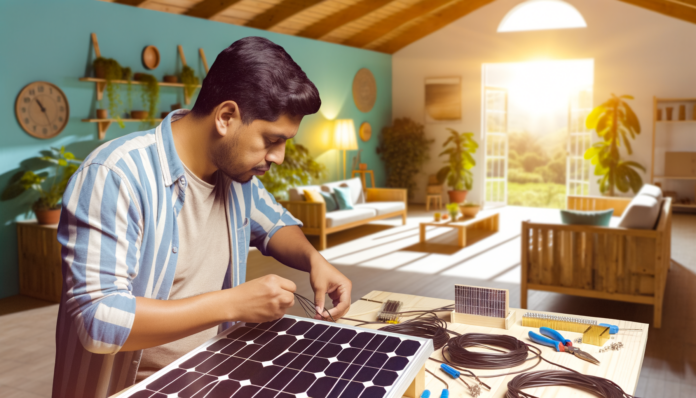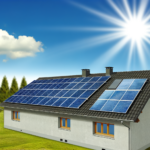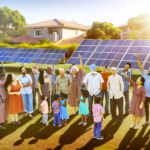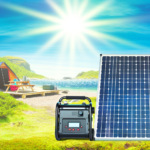Introduction to Sustainable Living and Solar Lighting
The Importance of Sustainability
In today’s world, the concept of sustainability has become more critical than ever. As we face the challenges of climate change, resource depletion, and environmental degradation, adopting sustainable practices is essential for ensuring a livable planet for future generations. Sustainable living involves making choices that reduce our environmental impact, conserve natural resources, and promote ecological balance. By integrating sustainability into our daily lives, we can contribute to a healthier planet and a more equitable society.
Benefits of Solar Lighting Solutions
Solar lighting solutions offer a myriad of benefits that align perfectly with the principles of sustainable living. Here are some key advantages:
- Energy Efficiency: Solar lights harness energy from the sun, a renewable and inexhaustible resource. This reduces reliance on fossil fuels and decreases greenhouse gas emissions.
- Cost Savings: Once installed, solar lighting systems have minimal operating costs. They eliminate the need for electricity from the grid, leading to significant savings on energy bills.
- Low Maintenance: Solar lighting systems are generally low-maintenance. With fewer moving parts and no need for wiring, they are less prone to mechanical failures and require less upkeep.
- Eco-Friendly: Solar lights reduce carbon footprints and minimize environmental impact. They do not produce harmful emissions or pollutants, making them a green alternative to traditional lighting.
- Versatility: Solar lighting solutions can be used in various settings, from residential gardens and pathways to remote areas without access to electricity. They are adaptable and can be scaled to meet different needs.
- Enhanced Safety and Security: Solar lights provide reliable illumination, enhancing the safety and security of outdoor spaces. They can be equipped with motion sensors and timers for added functionality.
Overview of the Article
This article aims to guide you through the process of crafting solar lighting solutions at home, promoting sustainable living practices. We will cover the following sections:
- Understanding Solar Power: Learn about how solar panels work, the different types of solar panels available, and the factors that affect their efficiency and performance.
- Materials and Tools Needed for DIY Solar Lighting: Discover the essential components, optional add-ons, and tools required to create your solar lighting system safely and effectively.
- Step-by-Step Guide to Crafting Solar Lighting Solutions: Follow a detailed guide on planning, assembling, wiring, installing, and troubleshooting your solar lighting project.
- Maintenance and Care for Solar Lighting Systems: Get tips on regular maintenance, common issues, and ways to extend the lifespan of your solar lighting system.
- Advanced Solar Lighting Projects: Explore advanced projects such as integrating smart technology, creating portable solutions, and scaling up for larger areas.
- Conclusion and Future of Solar Lighting: Recap the key points, discuss future trends in solar technology, and encourage the adoption of sustainable living practices.
By the end of this article, you will have a comprehensive understanding of how to implement solar lighting solutions in your home, contributing to a more sustainable and eco-friendly lifestyle.
Understanding Solar Power
How Solar Panels Work
Solar panels, also known as photovoltaic (PV) panels, convert sunlight into electricity through the photovoltaic effect. This process involves several key steps:
1. **Sunlight Absorption**: Solar panels are made up of many solar cells, which are typically composed of semiconductor materials like silicon. When sunlight hits these cells, it excites the electrons in the semiconductor material.
2. **Electron Movement**: The energy from the sunlight causes electrons to become loose from their atoms. These free electrons then move through the material to produce an electric current.
3. **Electric Field**: Each solar cell has an electric field that directs the flow of these free electrons, creating a direct current (DC) of electricity.
4. **Conversion to Usable Power**: The DC electricity generated by the solar cells is then converted into alternating current (AC) by an inverter. AC is the form of electricity used by most household appliances and the power grid.
This entire process allows solar panels to harness the sun’s energy and convert it into usable electrical power, making them a cornerstone of sustainable energy solutions.
Types of Solar Panels
There are several types of solar panels available, each with its own advantages and disadvantages:
1. **Monocrystalline Solar Panels**:
– **Efficiency**: High efficiency, typically around 15-20%.
– **Cost**: More expensive due to the manufacturing process.
– **Appearance**: Uniform black color, often considered more aesthetically pleasing.
– **Lifespan**: Long lifespan, often up to 25 years or more.
2. **Polycrystalline Solar Panels**:
– **Efficiency**: Slightly lower efficiency, around 13-16%.
– **Cost**: Less expensive than monocrystalline panels.
– **Appearance**: Blue color with a speckled look.
– **Lifespan**: Similar lifespan to monocrystalline panels.
3. **Thin-Film Solar Panels**:
– **Efficiency**: Lower efficiency, around 10-12%.
– **Cost**: Generally the least expensive.
– **Appearance**: Flexible and lightweight, can be integrated into various surfaces.
– **Lifespan**: Shorter lifespan compared to crystalline panels.
The choice of solar panel type depends on various factors including budget, space availability, and specific energy needs. Monocrystalline panels are ideal for those with limited space but a higher budget, while polycrystalline panels offer a good balance between cost and efficiency. Thin-film panels are suitable for unique applications where flexibility and weight are critical considerations.
Efficiency and Performance Factors
The efficiency and performance of solar panels are influenced by several factors:
1. **Sunlight Exposure**:
– **Direct Sunlight**: Panels perform best under direct sunlight. Shading from trees, buildings, or other obstructions can significantly reduce efficiency.
– **Orientation and Tilt**: The angle and direction of the panels should be optimized based on geographic location to maximize sunlight exposure.
2. **Temperature**:
– **Heat**: High temperatures can reduce the efficiency of solar panels. Panels are typically rated at 25°C (77°F), and performance can drop as temperatures rise above this level.
– **Cooling**: Adequate ventilation and cooling mechanisms can help maintain optimal performance.
3. **Quality of Components**:
– **Inverters**: High-quality inverters ensure efficient conversion of DC to AC power.
– **Wiring and Connectors**: Proper wiring and secure connections are essential to minimize energy loss.
4. **Maintenance**:
– **Cleaning**: Regular cleaning of the panels to remove dust, dirt, and debris can prevent efficiency loss.
– **Inspection**: Periodic inspections to check for damage or wear can help maintain optimal performance.
5. **Technological Advancements**:
– **New Materials**: Research into new materials and technologies continues to improve the efficiency and cost-effectiveness of solar panels.
– **Smart Systems**: Integration with smart technology can optimize energy production and usage.
By understanding these factors, homeowners and DIY enthusiasts can make informed decisions to maximize the efficiency and performance of their solar lighting solutions.
Materials and Tools Needed for DIY Solar Lighting
Essential Components
Creating a DIY solar lighting system requires several key components to ensure efficient and reliable operation. Here are the essential parts you will need:
- Solar Panels: These are the heart of your solar lighting system. Solar panels convert sunlight into electricity. For a basic setup, a 2V, 150mA solar panel is suitable for charging a AA NiMh battery. Ensure the panel size fits your project requirements.
- Rechargeable Batteries: Batteries store the electricity generated by the solar panels. Eneloop AA or AAA rechargeable batteries are highly recommended due to their long lifespan and ability to hold a charge for extended periods.
- Charge Controller: This device regulates the voltage and current coming from the solar panels to the batteries, preventing overcharging and ensuring efficient energy storage.
- LED Lights: LEDs are energy-efficient and provide bright illumination. A 0.5W straw hat white LED is a good choice for basic lighting needs.
- Inductor: Inductors help control the brightness of the LED lights. Values like 33uH and 47uH work well for 0.5W LEDs.
- Wiring and Connectors: Proper wiring and connectors are essential for linking all components together securely and efficiently.
Optional Add-ons for Enhanced Functionality
To enhance the functionality and efficiency of your DIY solar lighting system, consider incorporating the following optional components:
- Smart Controllers: These devices allow you to monitor and control your solar lighting system remotely via a smartphone app, providing real-time data on energy production and consumption.
- Motion Sensors: Adding motion sensors can help conserve energy by activating the lights only when movement is detected.
- Timers: Timers can be used to set specific on/off times for your lights, ensuring they operate only during desired hours.
- Additional Battery Storage: For extended lighting periods or to handle cloudy days, consider adding more battery capacity to your system.
- Reflectors and Diffusers: These can help direct and spread the light more effectively, improving the overall illumination of your space.
Tools and Safety Equipment
Building a DIY solar lighting system requires specific tools and safety equipment to ensure a smooth and safe assembly process. Here’s what you’ll need:
- Soldering Iron and Solder: Essential for connecting wires and components securely.
- Multimeter: Used to test the voltage and current of your solar panels and batteries, ensuring everything is functioning correctly.
- Wire Strippers and Cutters: Necessary for preparing and connecting wires.
- Screwdrivers and Drill: Useful for mounting solar panels and other components.
- Safety Gear: Always wear gloves and safety glasses to protect yourself from electrical hazards and sharp objects.
- Heat Shrink Tubing and Electrical Tape: These materials help insulate and protect electrical connections.
By gathering these essential components, optional add-ons, and necessary tools, you’ll be well-prepared to embark on your DIY solar lighting project. Remember, safety is paramount, so always follow best practices and guidelines when working with electrical components.
Step-by-Step Guide to Crafting Solar Lighting Solutions
Planning Your Solar Lighting Project
Before diving into the assembly process, it’s crucial to plan your solar lighting project meticulously. Start by determining the areas you want to illuminate and the type of lighting you need—whether it’s for pathways, garden accents, or security purposes. Calculate the total wattage required by considering the number of lights and their individual power consumption. For instance, if you plan to use two 10W LED bulbs for 12 hours each night, you’ll need a system that can produce at least 240W of power daily. Factor in inefficiencies and potential cloudy days by aiming for a higher production capacity, such as 480W per day.
Assembling the Solar Panel System
Once you have a clear plan, gather the essential components: solar panels, a charge controller, a battery, and LED lights. Begin by mounting the solar panels in a location that receives maximum sunlight, typically facing south in the northern hemisphere. Secure the panels using brackets and ensure they are angled correctly to capture optimal sunlight. Connect the solar panels to the charge controller, which regulates the voltage and prevents overcharging of the battery.
Wiring and Connecting Components
With the solar panels and charge controller in place, it’s time to wire the system. Use appropriate gauge wires to connect the charge controller to the battery. Ensure all connections are secure and insulated to prevent short circuits. Next, wire the LED lights to the battery, either directly or through a switch for manual control. If you’re using multiple lights, consider wiring them in parallel to ensure consistent voltage across all units.
Installing and Positioning the Lights
Positioning your solar lights correctly is key to maximizing their effectiveness. For pathway lighting, place the lights at regular intervals along the path, ensuring they are not obstructed by plants or other objects. For garden accents, position the lights to highlight specific features like flower beds or water fountains. Secure the lights firmly in the ground or on structures to withstand weather conditions. Ensure the solar panels on the lights are exposed to direct sunlight for efficient charging.
Testing and Troubleshooting
After installation, it’s essential to test the entire system to ensure everything is functioning correctly. Turn on the lights and check for consistent illumination. If any lights are dim or not working, inspect the wiring connections and ensure the battery is fully charged. Use a multimeter to check the voltage output from the solar panels and the charge controller. If issues persist, consult the manufacturer’s troubleshooting guide or seek professional assistance.
By following these steps, you can successfully craft a reliable and efficient solar lighting solution for your home, contributing to a more sustainable and eco-friendly lifestyle.
Maintenance and Care for Solar Lighting Systems
Regular Maintenance Tips
Maintaining your solar lighting system is crucial to ensure its longevity and optimal performance. Here are some essential tips:
- Clean the Solar Panels: Dust, leaves, and other debris can accumulate on the solar panels, reducing their efficiency. Clean the panels with a soft cloth and warm soapy water at least once a week to ensure they receive maximum sunlight.
- Check the Batteries: Regularly inspect the batteries for any signs of corrosion or leakage. Rechargeable batteries, such as Eneloop batteries, should be replaced every two years to maintain performance.
- Inspect the Wiring: Periodically check the wiring and connections for any signs of wear or damage. Ensure that all connections are secure and free from corrosion.
- Turn Off During Bad Weather: To extend the life of your solar lighting system, turn off the lights during heavy rain or storms. This prevents water damage and conserves battery life.
Common Issues and Solutions
Even with regular maintenance, you may encounter some common issues with your solar lighting system. Here are a few problems and their solutions:
- Dim or Flickering Lights: This could be due to dirty solar panels or depleted batteries. Clean the panels and replace the batteries if necessary.
- Lights Not Turning On: Check if the solar panel is receiving enough sunlight. Ensure there are no obstructions like trees or buildings blocking the sunlight. Also, inspect the sensor and make sure it is not exposed to other light sources that could interfere with its operation.
- Short Battery Life: If the batteries are not holding a charge, they may need to be replaced. Ensure you are using high-quality rechargeable batteries like Eneloop, which can be recharged up to 2100 times and hold 70% charge after five years of use.
- Weathered Solar Panels: Over time, the plastic covering the solar cells can become opaque, reducing efficiency. Use clear nail polish to rejuvenate the plastic and restore clarity.
Extending the Lifespan of Your System
To maximize the lifespan of your solar lighting system, consider the following practices:
- Optimal Placement: Place your solar lights in areas that receive direct sunlight for at least 6-8 hours a day. Avoid placing them near trees, walls, or other structures that could cast shadows on the panels.
- Regular Charging: Before using new solar lights, allow them to charge in direct sunlight for a full day. This ensures the batteries are fully charged and can provide maximum performance.
- Seasonal Adjustments: Adjust the tilt angle of the solar panels according to the season. For example, in the United States, set the panels’ tilt angle to 30 degrees in summer and 45 degrees in winter to maximize sunlight exposure.
- Protect from Extreme Weather: Store your solar lights indoors during severe weather conditions like storms or heavy snowfall to prevent damage.
By following these maintenance tips, addressing common issues promptly, and taking steps to extend the lifespan of your solar lighting system, you can ensure that your investment in sustainable lighting continues to provide benefits for years to come.
Advanced Solar Lighting Projects
Integrating Smart Technology
Incorporating smart technology into solar lighting systems can significantly enhance their functionality and user experience. **Smart solar lights** can be controlled remotely via smartphone apps, allowing users to adjust brightness, set schedules, and monitor energy consumption. These systems often include sensors that detect motion or ambient light levels, automatically adjusting the lighting to optimize energy use and provide security.
For instance, integrating **Internet of Things (IoT)** technology can enable solar lights to communicate with other smart home devices, creating a cohesive and automated environment. Imagine a scenario where your solar garden lights dim when you start a movie in your outdoor theater or brighten when someone approaches your driveway. This level of integration not only enhances convenience but also contributes to energy efficiency by ensuring lights are only used when necessary.
Creating Portable Solar Lighting Solutions
Portable solar lighting solutions are perfect for those who need flexible and mobile lighting options. These systems are ideal for camping, emergency situations, or simply moving around your property. **Portable solar lights** typically consist of a compact solar panel, a rechargeable battery, and an LED light, all housed in a durable, weather-resistant casing.
To create your own portable solar light, you will need:
– A small solar panel (5-10 watts)
– A rechargeable battery pack
– An LED light fixture
– A charge controller to manage the energy flow between the panel and the battery
Assemble these components in a sturdy, portable case, ensuring all connections are secure and weatherproof. The result is a versatile lighting solution that can be used anywhere, providing reliable illumination without the need for an external power source.
Scaling Up: Solar Lighting for Larger Areas
For those looking to illuminate larger areas such as gardens, driveways, or public spaces, scaling up solar lighting systems is a viable and sustainable option. **Large-scale solar lighting** projects require more substantial solar panels, higher-capacity batteries, and multiple light fixtures to cover extensive areas effectively.
Key considerations for scaling up include:
– **Solar Panel Size**: Larger panels (50-100 watts or more) are necessary to capture sufficient sunlight to power multiple lights.
– **Battery Capacity**: High-capacity batteries (100Ah or more) ensure that the system can store enough energy to provide consistent lighting throughout the night.
– **Light Distribution**: Strategically place multiple light fixtures to ensure even coverage and avoid dark spots.
For example, a solar-powered street lighting system might use a combination of high-efficiency LED streetlights, large solar panels mounted on poles, and centralized battery storage. These systems can be designed to operate independently or be connected to a microgrid, providing reliable and sustainable lighting for communities.
By integrating smart technology, creating portable solutions, and scaling up for larger areas, you can craft advanced solar lighting projects that meet a variety of needs while promoting sustainable living.
Conclusion and Future of Solar Lighting
Recap of Key Points
As we conclude our exploration of sustainable living through crafting solar lighting solutions at home, it’s essential to recap the key points discussed. We began by understanding the importance of sustainability and the numerous benefits of solar lighting solutions, such as reducing electricity bills, decreasing carbon footprints, and promoting energy independence. We delved into the workings of solar power, the types of solar panels available, and the factors affecting their efficiency and performance. We also provided a comprehensive guide on the materials, tools, and steps needed to create DIY solar lighting systems, emphasizing the importance of planning, assembling, wiring, and troubleshooting. Additionally, we covered the maintenance and care required to ensure the longevity of these systems and explored advanced projects integrating smart technology and scaling up for larger areas.
Future Trends in Solar Technology
The future of solar lighting is incredibly promising, driven by continuous advancements in technology and increasing global emphasis on sustainable living. Here are some trends to watch:
- Increased Efficiency: Ongoing research and development are leading to more efficient solar panels. Innovations such as perovskite solar cells and bifacial panels are expected to significantly boost energy conversion rates.
- Energy Storage Solutions: The integration of advanced battery storage systems will allow for better energy management, ensuring that solar power can be utilized even during non-sunny periods.
- Smart Solar Lighting: The incorporation of IoT (Internet of Things) technology will enable smart solar lighting systems that can be controlled remotely, offering features like automated dimming, motion detection, and energy usage monitoring.
- Flexible and Lightweight Panels: Developments in materials science are leading to the creation of flexible and lightweight solar panels, which can be easily installed on various surfaces, including curved and portable structures.
- Cost Reduction: As technology advances and production scales up, the cost of solar panels and related components is expected to decrease, making solar lighting solutions more accessible to a broader audience.
Encouragement to Embrace Sustainable Living
Embracing sustainable living through solar lighting solutions is not just a trend but a necessary step towards a greener and more resilient future. By adopting solar technology, you contribute to reducing greenhouse gas emissions, conserving natural resources, and promoting energy independence. Here are a few ways to get started:
- Start Small: Begin with simple projects like solar garden lights or small solar-powered devices to get familiar with the technology.
- Educate Yourself: Stay informed about the latest advancements in solar technology and sustainable practices. Knowledge is power, and understanding the benefits and workings of solar energy will empower you to make informed decisions.
- Community Involvement: Encourage your community to adopt solar lighting solutions. Collective efforts can lead to significant environmental benefits and cost savings.
- Advocate for Policies: Support policies and initiatives that promote renewable energy and sustainability. Your voice can help drive the adoption of clean energy solutions on a larger scale.
In conclusion, the journey towards sustainable living through solar lighting solutions is both rewarding and impactful. By taking small steps today, you can contribute to a brighter, cleaner, and more sustainable future for generations to come. Embrace the power of the sun and be a part of the global movement towards a greener planet.






